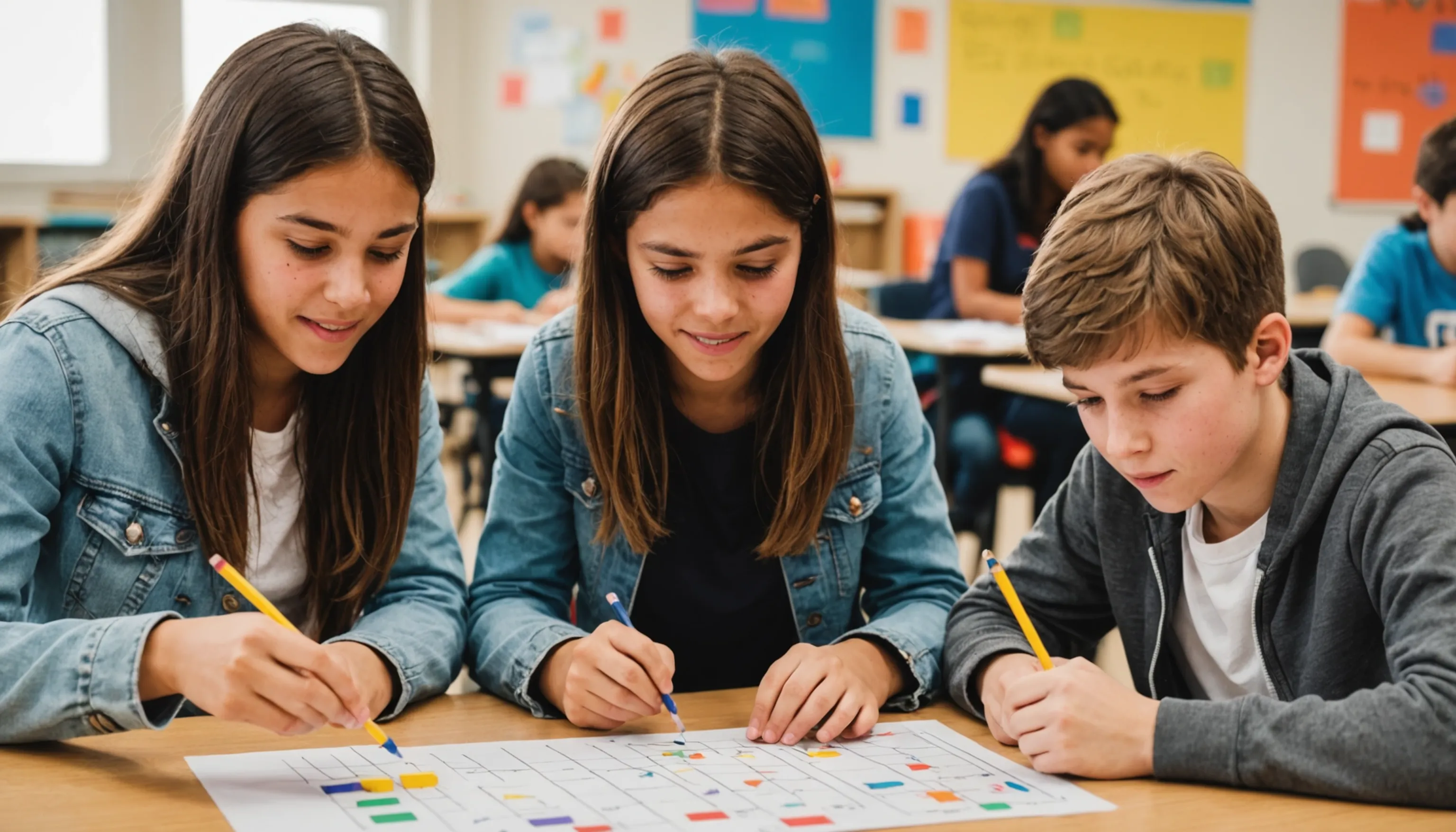After School Math Activities
 HvWHenry van Wagenberg
HvWHenry van Wagenberg
Engaging After School Math Activities for Teenagers
Engaging after school math activities for teenagers can transform their learning experience. These activities not only enhance their math skills but also make learning fun and interactive. Some effective approaches include math games, which can include board games or online platforms that challenge their problem-solving abilities. Puzzles are another excellent way to stimulate critical thinking. Additionally, involving real-world applications, like budgeting for a project or planning a trip, can help students see the relevance of math in everyday life. Ultimately, the goal is to create a supportive environment where teens feel motivated to explore and enjoy mathematics.
Why After School Math Activities Matter
After school math activities are crucial for teenagers as they provide an opportunity to reinforce learning in a relaxed environment. These activities help bridge the gap between classroom learning and real-life applications, making math more relatable and enjoyable. When students engage in math after school, they can explore concepts at their own pace, which fosters a deeper understanding and retention of material.
Moreover, after school programs promote critical thinking and problem-solving skills. For instance, participating in math games or puzzles encourages students to think outside the box and approach challenges creatively. This kind of engagement can help boost their confidence, especially in a subject that many find intimidating.
Social interaction is another essential aspect. Working on math projects or group activities allows students to collaborate, share ideas, and learn from one another. This collaborative learning environment not only enhances their math skills but also builds teamwork and communication abilities, essential for future success.
Additionally, after school math activities can spark interest in STEM (Science, Technology, Engineering, and Mathematics) fields. Engaging in fun and interactive math experiences can lead students to explore careers in these areas, which are crucial in today’s job market. Overall, after school math activities play a significant role in developing well-rounded, confident learners who appreciate the importance of math in everyday life.

Types of After School Math Activities
There are various types of after school math activities that cater to teenagers' diverse interests and learning styles. Here are some popular options:
- Math Games: Board games and online games that incorporate math concepts can make learning fun and competitive.
- Puzzles: Sudoku, logic puzzles, and brainteasers challenge students to think critically and enhance their problem-solving skills.
- Real-World Projects: Activities that involve budgeting, planning events, or conducting surveys can help students see the practical applications of math in everyday life.
- Creative Math Projects: Art-based projects that involve geometry or statistics can encourage creativity while reinforcing mathematical concepts.
- Technology Integration: Using math apps, software, and online resources can provide interactive learning experiences and cater to different learning preferences.
These activities not only make math enjoyable but also help students develop essential skills.
Math Games and Puzzles
Math games and puzzles are fantastic ways to engage teenagers in learning while having fun. These activities can significantly enhance their mathematical skills and critical thinking abilities. One popular category is board games designed with a math twist. Games like Monopoly or Prime Climb incorporate math concepts such as addition, subtraction, and strategic thinking.
Online platforms also offer a variety of interactive math games. Websites like Khan Academy and Prodigy provide gamified learning experiences that adapt to students' skill levels, making it easier for them to grasp challenging concepts.
Puzzles are another effective tool for promoting math skills. Activities like Sudoku and logic puzzles encourage logical reasoning and pattern recognition. Solving these puzzles can help students improve their problem-solving strategies and enhance their focus.
Additionally, math scavenger hunts, where students solve problems to find clues, can turn learning into an exciting adventure. By incorporating math games and puzzles into after school activities, educators and parents can create an enjoyable environment that fosters a love for math, boosts confidence, and encourages collaboration among peers.

Real-World Math Applications
Understanding real-world math applications is essential for teenagers, as it helps them connect mathematical concepts to everyday life. Engaging in activities that illustrate these applications fosters not only a deeper understanding of math but also enhances their problem-solving skills. One effective way to demonstrate real-world math is through budgeting exercises. Students can learn how to allocate their allowance or earnings, track expenses, and save for future purchases. This practical application teaches them the importance of arithmetic while instilling financial literacy.
Another engaging activity is planning a mock event, such as a party or a trip. Students can use math to calculate costs, measure distances, and manage time. This exercise requires them to apply addition, subtraction, multiplication, and even geometry to create a successful plan.
Additionally, incorporating statistics into real-world scenarios, such as analyzing sports data or conducting surveys, can help students see the relevance of math in making informed decisions. For instance, evaluating player performance or understanding trends in social issues encourages critical thinking.
By focusing on real-world applications of math, educators and parents can cultivate a deeper appreciation for the subject among teenagers. This approach not only boosts engagement but also prepares them for future challenges by equipping them with essential skills needed in various aspects of life.
Creative Math Projects
Creative math projects can significantly enhance teenagers' understanding of mathematical concepts while allowing them to express their creativity. These projects encourage students to explore math in innovative ways, making learning both enjoyable and memorable. One popular idea is to create a geometry art project. Students can use geometric shapes to design intricate patterns or sculptures, illustrating how geometry applies to art. This hands-on approach helps solidify their understanding of shapes, angles, and symmetry.
Another engaging project involves data collection and analysis. Students can conduct surveys on topics of interest, such as favorite hobbies or sports, and then create graphs or charts to represent their findings. This activity not only reinforces statistical concepts but also teaches them how to interpret and present data visually.
Additionally, math-related community service projects can be a great way to apply math skills while giving back. For example, students can help design a community garden layout, calculating area and dimensions, or assist in organizing a charity event by managing budgets and logistics.
Finally, integrating technology into creative math projects is also beneficial. Students can use software to create simulations or animations that represent mathematical concepts, such as fractals or transformations. By engaging in these creative math projects, teenagers develop critical thinking, problem-solving skills, and a genuine appreciation for the beauty of mathematics in everyday life.
How to Incorporate Technology in Math Activities
Incorporating technology into math activities can greatly enhance student engagement and understanding. Start by utilizing math apps like Prodigy or Khan Academy, which offer interactive exercises tailored to individual skill levels. Additionally, consider using online resources and games that reinforce concepts in a fun way. Educational videos can also be beneficial; platforms like YouTube provide visual explanations of complex topics. Finally, encourage students to use spreadsheets for data analysis projects, allowing them to visualize and manipulate data effectively. By blending technology with traditional methods, you can create a rich learning environment.
Math Apps and Online Resources
Math apps and online resources have revolutionized the way teenagers engage with mathematics, providing interactive and personalized learning experiences. One of the most popular platforms is Khan Academy, which offers a vast library of instructional videos and practice exercises across various math topics. Students can learn at their own pace, making it an ideal resource for both struggling learners and those seeking to advance their skills.
Another excellent app is Prodigy, a game-based learning platform that combines math practice with engaging gameplay. Students can create avatars, embark on quests, and solve math problems to progress in the game, which motivates them to practice regularly while having fun.
For those interested in geometry and visual learning, GeoGebra provides dynamic mathematics software that allows users to create constructions and models. This tool is particularly useful for visualizing geometric concepts and understanding their applications.
Additionally, websites like IXL and Mathway offer comprehensive practice and problem-solving assistance. IXL provides personalized recommendations based on student performance, while Mathway allows users to input problems and receive step-by-step solutions, helping them understand the problem-solving process.
By incorporating these math apps and online resources into after-school activities, educators and parents can foster a more engaging and effective learning environment. These tools not only make math more accessible but also encourage students to take ownership of their learning journey.
Using Educational Videos for Learning
Using educational videos for learning math has become an invaluable tool for teenagers, as it combines visual engagement with auditory instruction, catering to different learning styles. Platforms like YouTube host a multitude of channels dedicated to math education, such as Numberphile, 3Blue1Brown, and Khan Academy. These channels offer a range of content, from basic arithmetic to advanced calculus, allowing students to find resources that match their current understanding.
Educational videos are particularly effective for illustrating complex concepts. For instance, visual aids can simplify topics like algebraic equations or geometric transformations, making them more digestible. Animations and graphics help students visualize relationships between numbers and understand abstract ideas, which can be challenging to grasp through traditional textbook methods.
Moreover, videos allow students to learn at their own pace. They can pause, rewind, or rewatch sections that are difficult to understand, promoting a more personalized learning experience. Teachers can also incorporate these videos into classroom instruction, using them as supplementary material to reinforce lessons and initiate discussions.
Additionally, many educational videos include quizzes or interactive elements that encourage active participation, helping to solidify the concepts presented. By integrating educational videos into math learning, teenagers can develop a deeper understanding of mathematical principles while enjoying a modern and flexible approach to education. This method not only enhances their skills but also fosters a positive attitude toward learning math.
